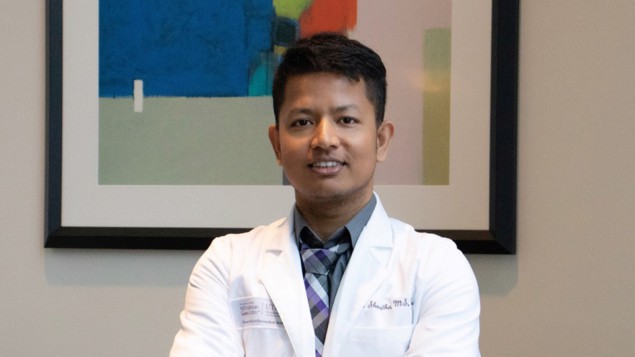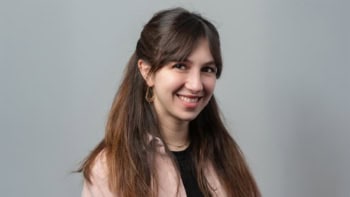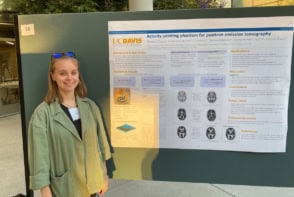Suman Shrestha, who is doing a PhD in medical physics in the US, tells Tami Freeman how the devastating earthquake that hit Nepal in 2015 has made him determined to one day bring his new-found skills and expertise back home

Suman Shrestha is a PhD student in medical physics at the University of Texas MD Anderson Cancer Center. He is originally from Nepal, where he studied for bachelor’s and Master’s degrees in physics at Tribhuvan University in Kathmandu. In 2015 Shrestha made the move from Nepal to the US to follow his interests in medical physics.
What first sparked your interest in physics and science?
My interest in physics and science developed gradually rather than due to a single event. I was a good student at school, and it was a general expectation of family and teachers in Nepal that top students will go into a scientific field. In the Nepali education system, you tend to specialize as soon as you start high school. If you’re interested in getting into medical school, you choose the biology track. If you’re more interested in understanding how the world works, you choose the physics track. I chose physics.
When you began your physics studies, was there a particular area you were most interested in going into?
During my adolescence, I had an interest in physical sciences and theories, and physical principles made sense to me. Clarity in terms of what specific sub-field I wanted to pursue came much later. I majored in physics during my undergraduate degree with a minor in chemistry and mathematics. By that time, I had had several run-ins with the inadequacy of medical facilities in Nepal, and many of these involved personal hardships and losses. As a physics student, I started looking for opportunities to make a difference in that area. But I had not identified a specific path to follow.
After your bachelor’s degree, you studied for an MSc in physics. What did that involve?
This was around 2010 and only about 120 students were chosen annually to study for an MSc in physics at Tribhuvan University. Students were selected based on an entrance test, with around 1500–2000 students competing for those 120 places. You had to be above the 95th percentile to have a chance of success. I still remember the joy that I felt when I made the merit list on my first attempt. That was a major milestone in my academic career because it meant that I would train with the best professors and the brightest colleagues. In terms of training infrastructure and international exposure, this was the best my country Nepal could offer. It was a tough three years of intense study, but that experience laid a strong foundation on which all my follow-up achievements rest. In 2013 I graduated with a double specialization in advanced solid-state physics and biomedical physics.
What made you decide to then do a Master’s degree in medical physics?
The medical and biomedical physics training that I did during my first Master’s was mostly theoretical except for a few laboratory experiments involving radioactivity. There were no advanced medical-physics degree options available. Also, the practical and clinical training opportunities were almost non-existent for a pure physics student. This level of training was not enough to help me make a substantial impact on the healthcare system, so after graduation, I had plans to pursue a PhD in medical physics. I started preparing for the Graduate Record Examination and Test of English as a Foreign Language, which are required for many postgraduate applications abroad. And during that time, I worked as a physics lecturer at the National Institute of Science and Technology, acquiring experience in teaching and advising undergraduate students.
How did you decide which specific course to enrol on?
In 2015 I had a few admissions offers for Master’s and PhD courses, and I later accepted the fully-funded offer from Louisiana State University (LSU) to do a Master’s. That offer was timely and life changing. In April 2015, when the application decisions were rolling out, one of the most catastrophic earthquakes struck Nepal, taking about 9000 lives and injuring 23,000 more. There was chaos everywhere, and the few hospitals that were left standing were overrun with patients. We did have some outstanding healthcare professionals and volunteers and students stepped up to the plate, but the inadequacy of medical facilities was clear. We lost some of the best and the brightest in that disaster. I was lucky enough to survive and be in a position to make a difference. So, with strong determination to make this life count, I left my home and came to the US to pursue my Master’s in medical physics.
What was it like moving to another country to study for your Master’s?
It was an adventure that I had dreamed of and worked towards for such a long time. I was excited about the future, but sad that I was leaving my home and my home country. It took about 52 hours for me to get from Kathmandu, Nepal to Louisiana, involving four different flights and long layovers. The first few weeks of the transition were tough, getting used to the new place and climate. It was very humid and hot. Staying on top of all the paperwork was not easy, but after starting classes I got to know amazingly compassionate people, outstanding scientists and great friends. I could not have asked for a better environment and it did not take long for LSU to become my home away from home.
During this time, you also had six months of clinical experience at Mary Bird Perkins Cancer Center in Louisiana. How did you find that opportunity and what did it involve?
During my Master’s in physics back home, I had tried to get clinical experience. I went to various diagnostic centres and hospitals and asked to shadow medical professionals. I was interviewed by administrators, engineers and vice-presidents of hospital organizations, but nothing seemed to work. I consider myself extremely lucky that I joined the medical-physics programme at LSU because on top of outstanding didactic and research training, LSU also has a clinical rotation experience for about six months embedded in the programme. You get a second office in a clinic where you rotate from one service to another.
I trained at the Mary Bird Perkins Center at Baton Rouge, its multiple satellite facilities and Pennington Biomedical Center. The level of immersion and training was just outstanding. It helped bolster my understanding of medical physics and also helped me integrate into the clinical environment and hospital culture.
Now you’re studying for your PhD at MD Anderson. What does your PhD project involve?
I work in the Late Effects Research Laboratory led by Rebecca Howell. The primary focus of our research group is the effects that can occur later in a patient’s life due to previous radiation therapy. We want to define the relationship between radiation dose to specific organs and late effects of these treatments in childhood cancer survivors. Then we want to work out how to minimize long-term effects of radiotherapy, particularly for children, who have their whole life ahead of them.
We want to work out how to minimize long-term effects of radiotherapy, particularly for children, who have their whole life ahead of them
I personally focus on developing models to predict the risk of radiation therapy-related late cardiovascular disease. We’ve made significant progress over the past few years. We developed and validated an age-scalable cardiac model that can be used to create dose-response models for the risk of late cardiac disease in childhood cancer survivors. This is the first time that we have that for late effects research.
I gather you already have a postdoc lined up. What will that project involve?
It will involve the clinical implementation of my PhD work. We have plans to integrate the risk-prediction models into existing treatment planning systems and establish their use via computational studies of current patients. Integrating these models into treatment planning systems through coding or scripting will make them readily available, and we plan to publish these scripts so that any centre around the globe can implement and use these tools. The idea is to develop the necessary clinical translation tools for a prospective clinical trial to reduce CVDs or cardiovascular disease in childhood and adolescent cancer survivors. For a newly diagnosed child, validated risk prediction models can be applied to optimize their radiotherapy plans and personalize their risk counselling based on treatment exposure and modifiable risk factors.
Looking further into the future, do you plan to stay in medical physics?
Yes. My goal is to become an independent researcher, a licensed medical physicist and, in the long run, a tenured professor. I plan to have my own research lab and students in the future. In addition, I’m also interested in improving healthcare in lower and middle-income countries. Later in my career, I want to establish research centres in Nepal with international collaboration so that future students can get the necessary training. I’m well aware of problems that one might face while attempting to institutionalize research in a country like Nepal, but I believe with excellent university education, perseverance and collaboration with well-resourced health centres, I will be successful in building a platform for the next generation.
For now, do you have any advice for current undergraduates in physics?
I’m an average student from a public school in Nepal who had big dreams. Now, I’m working towards my PhD while training with outstanding research scientists. It’s been a long journey with lots of ups and downs, failures and successes. I actually have even bigger dreams, bigger goals, and there’s a long way to go. I’m proud of where I am and hopeful for what the future holds.
My advice for current students is that if it’s possible for me, it should be possible for you as well. Your dream is likely to be different from mine, but if you persist and work towards it diligently, it can come true. It won’t be easy, but your hard work will be worth it.

Changing research field from astrophysics to neuroscience
I would also tell undergraduates that there are many hyper-competent and successful people in the world, and they enjoy finding promising young people and opening doors for them. Your job is to work hard and approach these people. My journey has been filled with so many mentors and my successes thus far would not have been possible without them.
My other tip would be to work on your communication skills. There is almost nothing more powerful than someone who can articulate their thoughts well. I’m still working on that and I will try to improve it over the next few years and throughout my life.



